Successful vegan and gluten free baking is all about making the right substitutions. Can you bake delicious treats without dairy, eggs, or wheat? Yes, you can, and you can learn how with this list of easy substitutions.
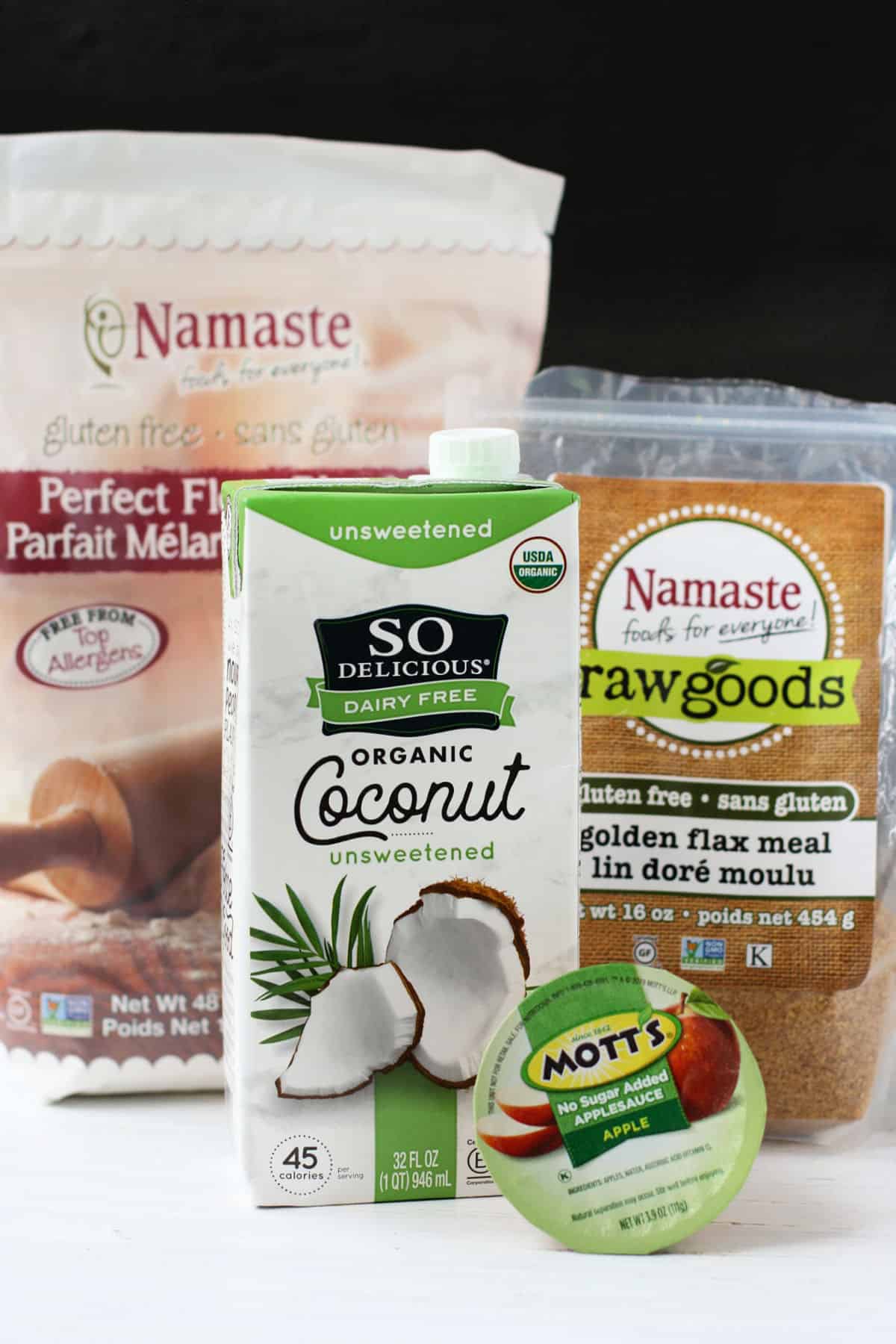
I know how it goes when you’re new to baking without dairy, eggs, or gluten. You think you’re going to try a new recipe and then you either find out that it requires a ton of new, hard to find ingredients, or the recipe seems easy enough, and then something goes awry, and you have flat cookies or a cake that sank in the middle.
It’s so frustrating, isn’t it?
If you use the right ingredients and trusted recipes, anyone can make delicious gluten free and vegan baked goods. I’m going to share some common substitutions with you today. I hope that these ideas for substitutions will help you as you venture into the world of gluten free and vegan baked goods.
This list is just meant as a general, quick start guide for those who are new to baking dairy, egg, and gluten free.
This list is not going to cover every food allergy out there, but is meant to help those who love to bake, but need some ideas for baking without dairy, eggs, and wheat.
This is the information that I wish I would have had after my second son was born, and I had to eliminate dairy, eggs, wheat, soy, and corn from my diet. I still really wanted to bake, but in my sleep deprived state, it was difficult for me to figure out exactly where to start.
Disclaimer: I am not a healthcare professional – please consult your doctor if you are not sure if an ingredient is safe for you or your family.
Jump to:
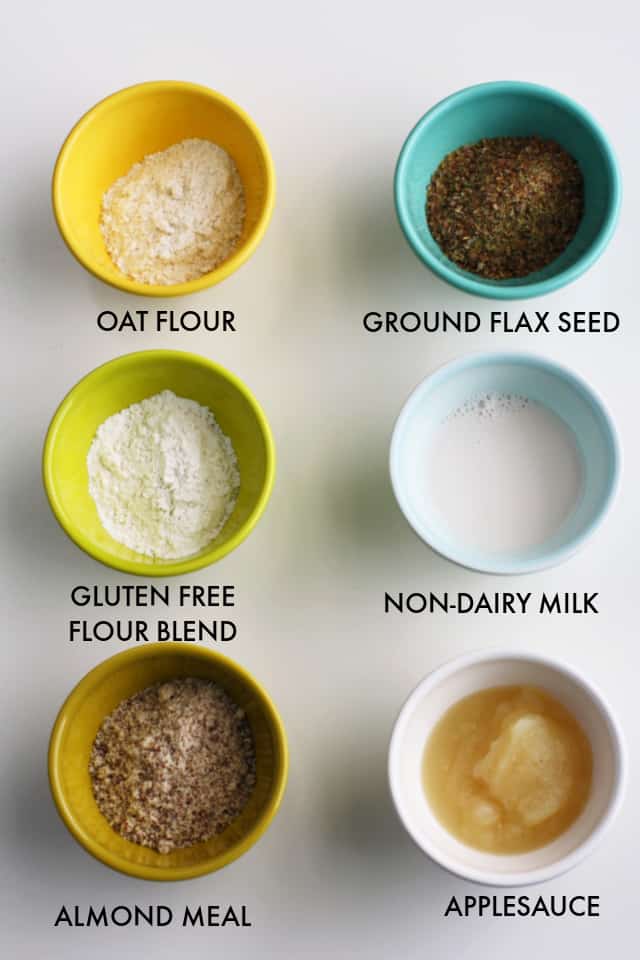
Gluten Free Flours
Gluten Free Flour Blends – There are so many great gluten free flour blends available these days. Most gluten free flour blends that you find in stores are a blend of rice flours, starches like potato starch or tapioca, and other flours like sorghum or garbanzo bean flour. These flours are selected because when they combine, they offer the best results for gluten free baking.
The gluten free flour blends that I prefer are a cup for cup substitution for regular flour. Namaste Foods, 123 Gluten Free, and Living Now Foods all make gluten free flour blends that are made in allergy friendly facilities.
There are a lot of other options out there, if you don’t need to avoid other allergens. King Arthur, Bob’s Red Mill, and Arrowhead Mills make gluten free flour blends, but there are allergens in the facilities where they are produced.
You can also make your own blend. There are lots of recipes online if you choose to go that route. I also have a recipe that I use and love for homemade gluten free flour.
Oat Flour – Oat flour is another gluten free flour option, although it does have a different texture than wheat flour.
One way to use oat flour is to use part oat flour, and part gluten free flour blend. If you’d like to use only oat flour, that will work best for cookies, like these chocolate chip cookies. Oat flour has a very delicate texture, and using only oat flour in a cake can result in a crumbly cake.
Oats do not contain gluten, although they can be cross contaminated if they are made in a factory that does not process wheat as well. As long as the oat flour is made in a a certified gluten free facility, it should be free of gluten. You can also make your own oat flour by grinding certified gluten free whole oats in a food processor until they become a fine flour.
Almond Meal – If you don’t have a nut allergy, almond meal can be a great option for grain free baking. It does tend to make baked goods a little bit heavier, but also very flavorful and moist. Again, I recommend using almond meal for up to half of the amount of flour that the recipes calls for. Use a lighter flour, like a gluten free blend for the remainder of the amount of flour required.
Coconut Flour – Coconut flour is a very heavy flour, and unless you are using it with actual eggs, it is not a good choice for gluten free baking. Coconut flour really absorbs a lot of moisture and can make baked goods dense and heavy. If you are able to eat regular eggs, then it may work for you.
Egg Substitutes
There are a few options for egg replacers.
Flax Egg Replacers – You can make flax seed eggs, which work very well for cookies and muffins. It’s really simple to make a flax egg: for each egg that you need to replace, just mix 1 Tablespoon of ground flax seed meal with 3 Tablespoons of water. Let it sit for a few minutes, and it will form a gel. Once it has gelled up, add it to your batter as you would a real egg.
Chia Seed Eggs – This is another option. To make a chia egg: grind up 1 Tablespoon of chia seeds with a mortar and pestle, and mix with 3 Tablespoons of water, and let it sit for a few minutes until it forms a gel, then add to your batter. Chia seed eggs are a good choice for cookies or muffins. If you don’t want to see the little black specks, choose white chia seeds, which are lighter in color.
Unsweetened Applesauce – Applesauce is a good choice for cupcakes, cakes, or muffins. For each egg that the recipe calls for, simply substitute 3 Tablespoons of applesauce.
Dairy Free Yogurt – Your favorite dairy free yogurt (I like coconut milk yogurt), can work well as an egg replacer. Use the same ratio as with applesauce: 3 Tablespoons of yogurt for each egg required in the recipe.
Baking Powder and Vinegar – Sometimes a combination of a leavening agent, like baking powder, and an acid, like apple cider vinegar or lemon juice, is a great choice for helping vegan cakes and muffins to rise. This vegan cupcake recipe uses this type of egg replacer.
If you’d like to learn more about egg substitutes, read my complete guide to egg replacers.
Dairy Substitutes
Dairy substitutions are actually pretty easy because there are so many great products available now. More and more people are following plant based diets, so that has resulted in lots of new products coming to market. From oat-based products, to coconut, rice, soy, flax, and more, there are many dairy free milks, yogurts and more available at the store.
Non-Dairy Milk – When a recipe calls for milk, just use an equal amount of non dairy milk. Some options include coconut milk, rice milk, soy milk, almond milk, and hemp milk. Use whatever milk suits your preference and dietary needs. You will want to avoid overly sweetened and flavored milks – try to choose a neutral tasting milk for best results.
Sometimes water will work in place of milk. If you’re making a cake or pancakes, water will be okay in place of milk – just use an equal amount.
Vegan Butter – For butter, we use Earth Balance Soy Free Vegan Buttery Spread. It has a great buttery flavor, and works really well in baking and on top of toast, pancakes, etc. Earth Balance makes a variety of vegan buttery spreads and baking sticks.
Oil or Shortening – You can also experiment with using coconut oil, or vegan shortening, like the Spectrum brand.
Coconut oil can also work in some recipes. Be sure to read if you should measure it as a solid or as a liquid before adding it to your batter.
Corn Free Baking Tips
Baking Powder – When we were avoiding corn, we discovered Featherweight Baking Powder, which is corn free. Most baking powders contain cornstarch. You can find Featherweight Baking Powder online as well as at some health food stores, like Whole Foods.
Cornstarch – Cornstarch is often used to thicken sauces, puddings, and gravies. You can substitute an equal amount of tapioca starch or arrowroot powder in recipes that require cornstarch.
Confectioner’s Sugar – Confectioner’s Sugar or powdered sugar is often a mix of cornstarch and sugar. Wholesome Sweeteners Powdered Sugar is corn free, and can be found at Fresh Thyme, Whole Foods, and at Vitacost.
Tips for Success
- If you are adapting your favorite recipes to be wheat free, gluten free, or vegan, you need to be aware that you may need to tinker with the recipe. A recipe that was written to contain wheat and dairy ingredients may not work perfectly the first time you use substitutions.
- When you’re using gluten free flour, the baking time might vary! Gluten free flours absorb liquids differently. Keep an eye on everything while you are baking so that you don’t have over or under-done baked goods.
- Use parchment paper to keep gluten free cookies and cakes from sticking to the pan.
- Chill gluten free vegan cookie dough to prevent it from spreading out too much on the cookie sheet.
Be patient! With a little bit of time and practice, you’ll get the hang of baking with these new ingredients.
Printable Substitution Chart
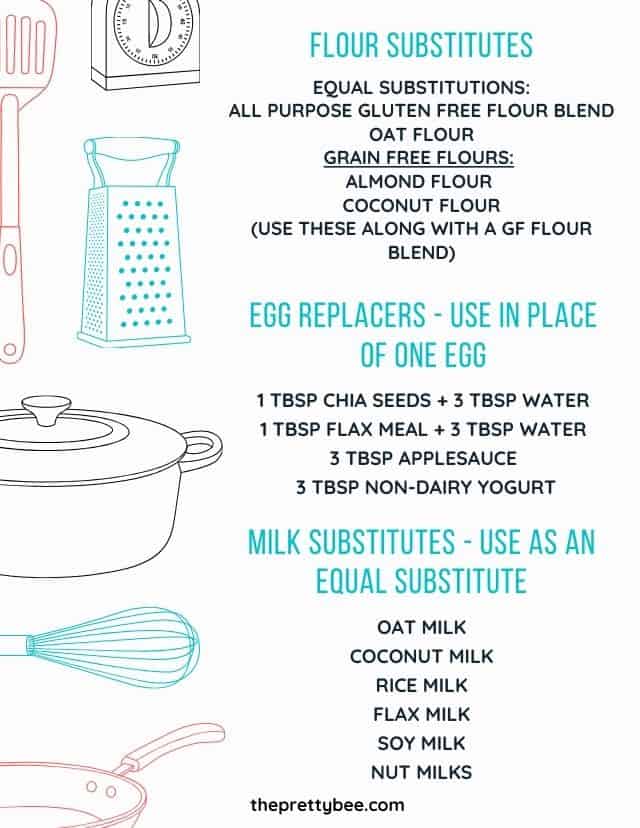
If you’d like to get the handy printable chart above, click here.
If you’re new to food allergies, you may want to visit this page to learn more about baking and cooking for food allergies.
Easy Recipes to Try
Some links to favorite EASY gluten free and vegan recipes to get you started:
Baking Ebook
If you’d like even more detailed information about baking desserts that are free of the top allergens, you may want to check out my ebook, Top 8 Free Baking for Beginners. It’s a collection of tips, tricks, and recipes that will have you baking up delicious treats in no time!
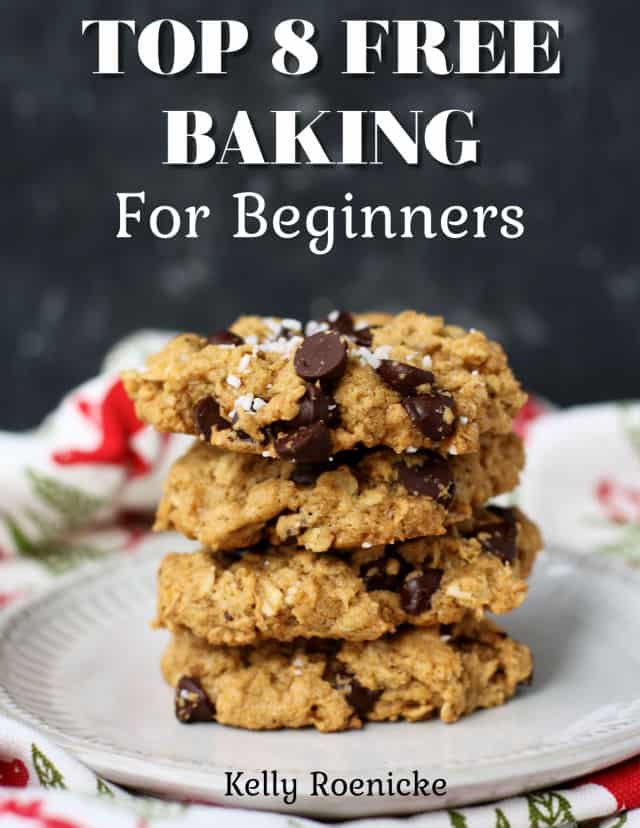


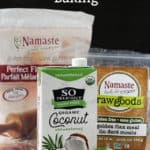
Beverly Ann Stevens
Thanks for the wheat, dairy, & egg replacement info! I didn’t know about cornstarch in confectionery sugar but the consistency is the same as corn starch!
Vegan desserts call for lots of sugar! I realize pure maple syrup & honey maybe a substitute. I read that agave has the same detrimental qualities as high fructose corn syrup reaction in the body!
Are there any ratio charts to substitute sugar with pure maple syrup &/or other subsitutes such as stevia powder versus a stevia liquid like extract?
I love using organic unrefined coconut oil because it seems to impart a natural sweetness in baked goods?
I appreciate your helpful suggestions & recipes. Thank you very much!
Norma
This information was really helpful, thank you!!!
Rajshree Menon
Thank you so much! Your emails are always so full of such great information and recipes.
Thank you again for the effort you put into helping those of us trying to navigate the world of allergies!
Kelly Roenicke
You’re welcome!
Kathi @ Deliciously Yum!
What a great roundup! I’ve recently started to look for substitutions when it comes to baking and your tips will definitely come in handy :). Love how detailed this post is – so helpful. Thank you!!
Kelly
I’m so glad that you found it helpful, Kathi! Thanks so much for stopping by!
Heidi (hi-d @ hi-d's place)
Hi Kelly,
This whole gluten free thing really seems to be catching on. Although I don’t have any food allergies, (as far as I know), I think it’s great to try alternatives. I love Trader Joe’s…might have to check out their gluten free bread. :)
Thanks,
Heidi
Kelly
Lots of people are gluten intolerant for sure! I’m glad you don’t have to deal with that in your family. Thanks for stopping by, Heidi!
Natalie @ Tastes Lovely
So helpful! Thanks for all this info Kelly! I should try out more vegan and gluten free baking recipes.
Kelly
You’re welcome, Natalie! It isn’t too hard to adapt recipes if you know what to use! :)
Allison @ Clean Wellness
This is super helpful! Thanks for putting this info out there. My sister has celiac disease, so she can’t eat spelt, but everything else (as long as it’s not contaminated) is good for her. I personally find spelt much easier to digest than regular wheat for sure. I have yet to try the applesauce trick in my vegan baking, but I must! I’d like to see how it compares to the chia/flax mixture I usually use. Great post! :)
Kelly
Thanks so much, Allison! I hope this post helps some people who are new to baking this way! I do like the applesauce better than flax/chia eggs for some recipes. Or sometimes I use one flax egg and one applesauce replacement if it calls for two eggs. It’s fun to experiment to see what works! :)